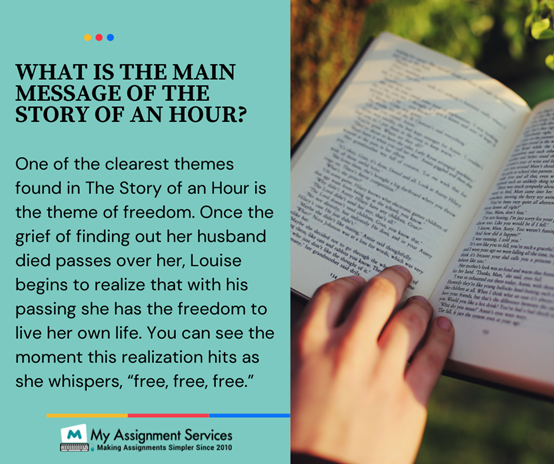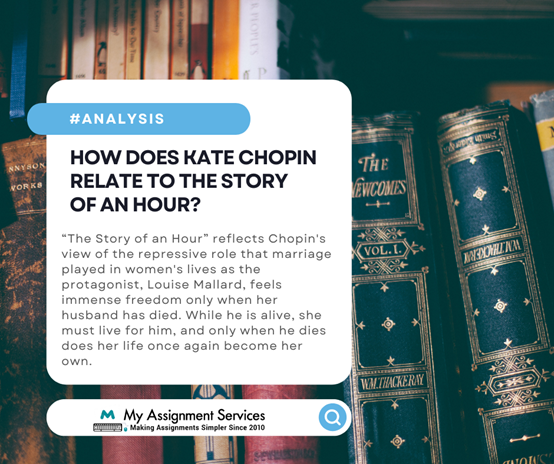
‘The Story of an Hour’ is a short story written by Kate Chopin, a Louisiana woman who was a pioneer for American women writers. Published in 1894, the story tells of a woman who faints upon learning her husband has died in an accident. When she comes to, she learns that it was only a misunderstanding - he wasn't dead! This realization brings on different emotions, from deep grief to joy and excitement.
In the analysis of the essay, we tend to provide a brief summary of "The Story Of An Hour," followed by some main points about the symbolism of setting, characters, and objects. We will apply these points towards understanding how Chopin may have used setting and symbolism to construct meaning within this specific literary piece. This blog post will explore Mrs Mallard's emotional journey and why some believe that she was happy to hear of her husband's death.

Brief Of "The Story Of An Hour" By Kate Chopin
Louise Mallard, the protagonist in The Story of an Hour, lives with her husband, a newly married woman. Her husband has just returned from a business trip when Louise begins to daydream while alone in the house after being informed that he had died in a train accident during his trip back home. She imagines what life would be like if she were free from the restrictions that are imposed upon her through marriage. As she goes deeper into these fantasies, she experiences freedom and empowerment. At one point, she even thinks about how much easier it would have been for Brentley to die than for him to return home and demand that they live as man and wife.
The protagonist is introduced as someone who lives under the mental strain of trying to please her husband and live up to societal expectations of women at that time, specifically in the 19th century. She also deals with the grief of losing her father's company following his death. All this pressure eventually leads to Louise developing an illness, aggravated by all the stress she feels deep-down about living a life she never wanted for herself. Tired of living this way, Louise imagines what life would be like if Brentley were dead instead - thus mistaking him for being dead due to her illness. When she wakes up after fainting upon learning that her husband was not lost but had arrived home, Louise realises how much more accepting she is of the life she has now instead of the one she wished for.
The Story Of An Hour provides an excellent example of how setting can be used to establish mood, which in this case is enhanced by symbolism. The short story takes place during a specific time of day - not long after dawn and before noon. This particular period was chosen to represent Louise's fantasy, where her new identity as a sexually liberated woman capable of taking care of herself becomes apparent. As such, the environment around Louise undergoes subtle changes too: "Angry spots burn in her cheeks; something aches in her sternum." Chopin makes use of these details to indicate that Louise is becoming increasingly excited and emboldened as time goes by - thus allowing her to "call out softly at intervals" and approach the window. The Story of an Hour conveys its message through symbols, which are presented in three main forms: symbolism of setting, the symbolism of characters, and symbolism of objects.
Symbolism of Setting
Chopin uses the close surroundings for Louise as a symbol of transformation throughout the story. For instance, it is described how the morning has become afternoon by the time Louise regains consciousness from fainting: "the afternoon was well advanced". Along with this change in time comes a shift in weather - from relatively clear skies to raindrops hitting against windows. This highlights Louise's altered emotional state as she now seems calm instead of anxious about Brentley's return. She feels "more at peace with the world". The same window she was looking out of moments ago now becomes a gateway to freedom as Louise imagines what life might have been like if Brentley were dead instead.
Symbolism Of Characters
Chopin's characters are masters in projecting the underlying meanings of the story. For example, readers learn that Louise is normally subservient to her husband but takes advantage of his absence to indulge in thoughts that contradict everything she has been led to believe about women and how they should behave. Other characters, such as Mrs Mallard, show signs of being unhappy in their marriage yet still count on the legal bond between them - even though it isn't working for either partner. She can thus be seen as taking the only way out that is allowed to her.

Symbolism of Objects
The significance of objects in The Story Of An Hour lies in how they interact with and mirror Louise's changing moods. For instance, she feels "they were all suspended about her" while standing at the window - for this is when Louise has an epiphany and realizes that Brentley will never truly be able to satisfy her needs. Chopin also chooses specific items such as carriages and horses to communicate Louise's inner confusion: these are used to describe what Louise sees outside but soon lose their meaning because she can't get past her own mixed feelings about Brentley's return.
A particular object in the story, a clock on the mantel, is an apt symbol of the short story itself. Even though Chopin tells readers that "the strokes were beating monotonously" - thereby suggesting a lack of change in Louise's life - the reader soon learns how wrong this impression is, for this is when Louise experiences a transformation.
Message From The Story of an Hour
Anxiety about Brentley's return to his wife turns into freedom from marriage as she imagines life without him. The Story Of An Hour conveys its message through symbols, which are presented in three main forms: symbolism of setting, characters, and objects. The close surroundings for Louise Mallard become a symbol of transformation throughout the story. For example, it is described how the morning has become afternoon by the time Louise regains consciousness from fainting: "the afternoon was well advanced". Along with this change in time comes a shift in weather - from relatively clear skies to raindrops hitting against windows. This highlights Louise's altered emotional state as she now seems calm instead of anxious about Brentley's return. She feels "more at peace with the world".
The same window she was looking out of moments ago now becomes a gateway to freedom as Louise imagines what life might have been like if Brentley were dead instead. Chopin's characters are masters in projecting the underlying meanings of the story; for example, readers learn that Louise is normally subservient to her husband but takes advantage of his absence to indulge in thoughts that contradict everything she has been led to believe about women and how they should behave. Other characters, such as Mrs Mallard, show signs of being unhappy in their marriage yet still count on the legal bond between them - even though it isn't working for either partner. She can thus be seen as taking the only way out that is allowed to her.
The significance of objects in The Story Of An Hour lies in how they interact with and mirror Louise's changing moods; for instance, she feels "they were all suspended about her" while standing at the window - for this is when Louise has an epiphany and realises that Brentley will never truly be able to satisfy her needs. Chopin also chooses specific items such as carriages and horses to communicate Louise's inner confusion: these are used to describe what Louise sees outside but soon lose their meaning because she can't get past her own mixed feelings about Brentley's return. A particular object in the story - a clock on the mantle - is an apt symbol of the short story itself. Even though Chopin tells readers that "the strokes were beating monotonously" - thereby suggesting a lack of change in Louise's life - the reader soon learns how wrong this impression is, for this is when Louise experiences a transformation.
Concluding Lines
Louise's fearless expression on her face after she has made up her mind about how to deal with Brentley's return shows that this is a woman of action, not of anxiety and indecision. Her newfound sense of liberation comes from knowing that soon nobody will ever again be able to dictate the terms of her life: "She had not realised before just what it was that she did want. But now -. She did not finish the process of thought in words." The Story Of An Hour conveys its message through symbols, which are presented in three main forms: symbolism of setting, characters, and objects.
My Assignment Services is the perfect place to solve all your academic woes, whether it is assignment help or exam assistance. We are here to assist you 24/7, 365 days a year! If you're looking for an expert who can help with your English assignments with exemplary assistance, then we can provide that and more. We offer a variety of services like 1:1 sessions, assistance with proofreading and editing, and any need you may have. We'll guarantee top marks for all of your work! Just fill in the form and mention your query. We will connect you with one of our English assignment experts who will resolve them instantly.
Related Study Materials
Our Experts can answer your Assignment questions instantly.
Ask Question0 Comment
Get It Done! Today
1,212,718Orders
4.9/5Rating
5,063Experts













Loved reading this Blog? Share your valuable thoughts in the comment section.
Add comment